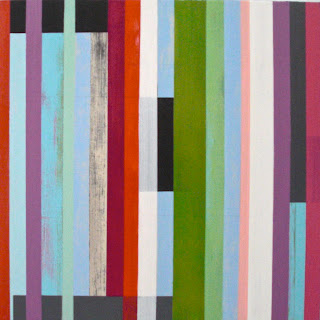"Root"
20"x 20"
Acrylic & Oil
Canvas on Panel
"Modal Change"
24" x 48"
Acrylic & Oil
Canvas on Panel
The "groove" is a key component in my painting process.
Wikipedia:
Groove is the sense of propulsive rhythmic "feel" or sense of "swing" created by the interaction of the music played by a band's rhythm section(drums, electric bass or double bass, guitar, and keyboards). Groove is a consideration in genres such as salsa, funk, rock music, fusion, and soul. The word is often used to describe the aspect of certain music that makes one want to move, dance, or 'groove'.
Musicologists and other scholars began to analyze the concept of "groove" in the 1990s. They have argued that a "groove" is an "understanding of rhythmic patterning" or "feel" and "an intuitive sense" of "a cycle in motion" that emerges from "carefully aligned concurrent rhythmic patterns".
I have a passion for the groove! Jazz/fusion of various genres (particularly piano). Listening to musicians grooving with their intuitive sense of " aligned rhythmic patterns" affects and energizes my inner and outter response in the studio. Showing up, preparing, concentrating, a painting begins-- laying down a line, a form, a color, a surface.
The groove of recurring pulses, structure in the pulses, repeat rhythm patterns, and the repeat of this "groove" beat transports me to a special zone. Musicians call it "the groove", atheletes and artists sometimes relate this same feeling as being "in the zone". Whether in the 'zone' or in the 'groove', an artist finds the hours passing quietly-- in painting, writing, performing or practicing their art form.
This new series "Groove" reveals a different type of pattern and complexity. The comp and layers are appearing rhythmically repetitive and riff-like. Some recent feedback on the work has been referenced to music. It is satisfying to hear this response to the work.
I use whatever paints I have and mix my own colors. The form-color-harmony works itself out. A lot of the time, I paint myself into a corner not knowing what's going to happen. I have practiced not abandoning or prematurely destroying what isn't working. I step away, let the painting breathe and return later or work on another piece. These paintings are satisfyingly challenging as I push and pull the work to a new edge. My work concerns making serial paintings with complex comps, surfaces and color relationships leading to a moving rhythmic field.
Here is a look at the working out of a painting.
(Below are a few evolving shots of "Compression 2").
Process shot of a point when abandon & destroy arises.
The next session of painting my way out.
The form's influence on colors... and, color's influence on forms....
The particular "groove" inspiring these paintings come from a long history of listening and spending time at the piano figuring out the complex compositions of "Joe Sample" -- an American pianist, keyboard player and composer ( one of the founding members of the Jazz Crusaders).
I am having fun with this new shift in the work & facinated with exploring more on music, color, form and painting.
The Imperfect Art: Reflections on Jazz and Modern Culture”
Author & Musician Ted Gioia has this to say:
Errors will creep in, not only in form but also in execution; the improviser, if he sincerely attempts to be creative, will push himself into areas of expression which his techniques may be unable to handle. Too often the finished product will show moments of rare beauty intermixed with technical mistakes and aimless passages.
(Ted Gioia is one of the outstanding music historians in America & his most recent book is
"The Birth (and the Death) of Cool").Kandinsky's "Concerning the Spiritual in Art" exerpt:
"Any realization of the inner working of colour and form is so far unconscious. The subjection of composition to some geometrical form is no new idea. Construction on a purely abstract basis is a slow business, and at first seemlingly blind and aimless. The artist must train not only his eye but also his soul, so that he can test colours for themselves and not only by external expressions."
"I like painting -- it's like jazz -- it goes where it takes you"
-Brian Eno
(English musician, composer, record producer, music therorist, singer and visual artist)
"The way we respond to color is similar to the way we respond to music: words fail us"
- Robert Swain - American Painter





